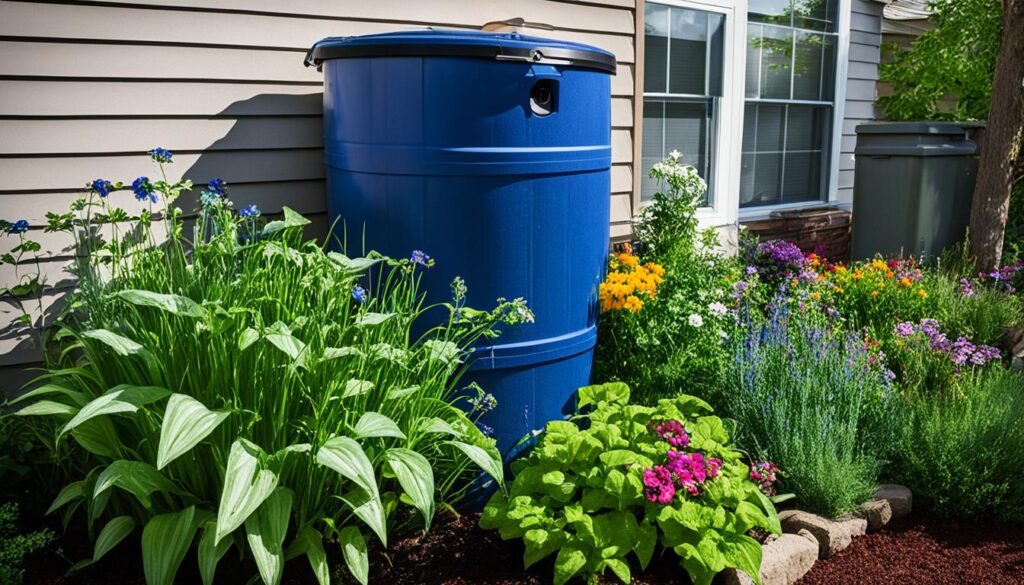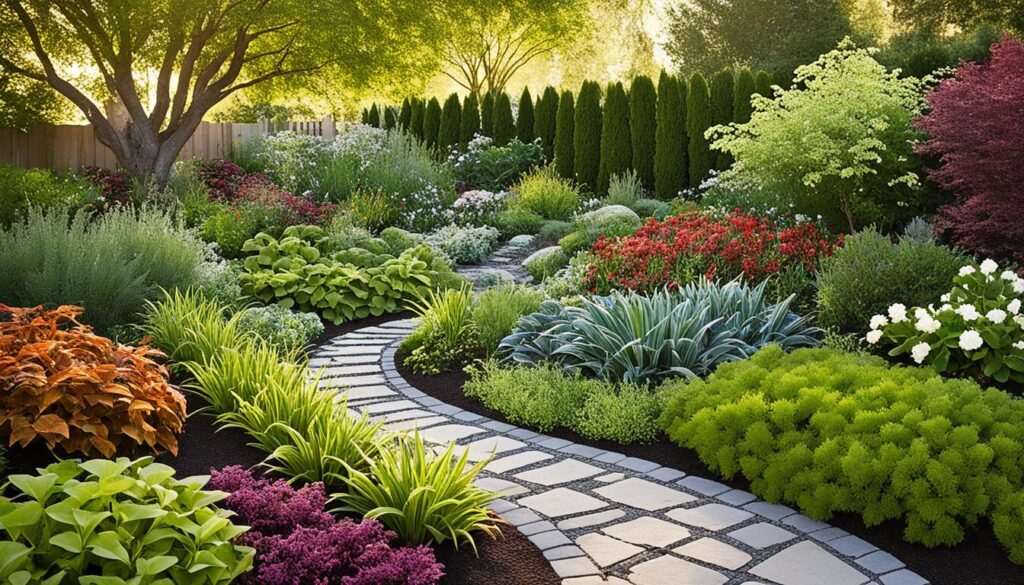Gardening for Climate Change Resilience
How can your garden stand strong against climate change? Learn how to make your garden a symbol of resilience. Discover the power of climate-resilient gardening. Turn your outdoor space into a sustainable haven that can face any challenge.
Key Takeaways
- Adapt your garden to the challenges of climate change through sustainable practices
- Reduce your carbon footprint by embracing eco-friendly gardening techniques
- Enhance soil health and plant diversity to create a resilient, self-sustaining ecosystem
- Conserve precious water resources and harness the power of nature to manage stormwater
- Grow local, heat-tolerant crops to build food security and minimize waste
Understanding Climate-Resilient Gardening
As the climate changes, gardeners need to adapt. They must create climate-resilient and sustainable landscapes that can handle variable weather and extreme events. Climate-resilient gardening is about making gardens that can survive a climate-friendly future.
What is Climate-Resilient Gardening?
Climate-resilient gardening is about making gardens better at adapting and recovering from climate change. It means dealing with more heatwaves, unpredictable rain, and “false springs” that harm plants. By using sustainable methods, gardeners can make green spaces that are ready for a changing climate.
Impacts of Climate Change on Gardening
Climate change brings new challenges to gardeners, such as:
- More heatwaves, droughts, and heavy rains
- Changes in plant hardiness zones, making some plants hard to grow
- Disruptions to pollinators and new pests
- Higher risk of plant diseases and damage from extreme weather
To overcome these problems, gardeners should use climate-resilient gardening methods. These help their gardens do well even with the changing weather.
Reducing Carbon Footprint in Gardening
Gardeners can make a big difference by cutting down on their carbon footprint. Switching to electric or manual garden tools is a great step. These tools don’t just reduce greenhouse gas emissions. They also make gardening quieter and cleaner.
Another good move is to reduce the size of our lawns and try lawn alternatives. Big lawns need a lot of mowing, which uses more fuel and fertilizers. These things add to greenhouse gas emissions. By using less lawn and adding diverse, tough plants, we can cut down on mowing and fertilizer. This makes our gardens more sustainable.
Using Electric or Manual Garden Tools
- Switch from gas-powered to electric or manual garden tools, like mowers and trimmers, to reduce greenhouse gas emissions.
- Electric tools are quieter and use less energy than gas ones.
- Manual tools, like push mowers and hand trimmers, are a low-carbon choice. They also help you get a workout while you garden.
Reducing Lawn Area and Fertilizer Use
- Look at your lawn and think about reducing its size. You could replace it with drought-tolerant plants, groundcovers, or even vegetable gardens.
- Use less fertilizers because they can harm the environment.
- Try organic gardening methods, like composting, to make your soil better. This cuts down on the need for synthetic fertilizers.
By making these changes, we canreduce our carbon footprint. This helps make our gardens and the planet more sustainable.
Planting for Energy Conservation
Adding energy-efficient landscaping to your garden can save a lot of energy and help fight climate change. Planting trees smartly around your home is a key strategy.
Benefits of Planting Trees
Trees act like natural air conditioners, shading buildings and cutting cooling costs. Shade trees can make indoor temperatures drop by up to 20 degrees Fahrenheit. This can save you up to 50% on air conditioning bills.
Evergreen trees also help by blocking cold winter winds, lowering heating costs. They protect your home from harsh winds, keeping you cozy inside.
Trees are great for fighting climate change too. They take in and store carbon dioxide, which helps reduce greenhouse gases. This action helps slow global warming.
Strategic Tree Placement for Shade and Wind Protection
- Plant deciduous trees on the south and west sides to cool your home in summer.
- Put evergreen trees or shrubs on the north and west sides to block cold winter winds.
- Don’t plant trees too close to your home to prevent damage to foundations and structures.
By planting trees thoughtfully, you can cut your energy use and help fight climate change. Trees do more than just save you money; they help the planet too. This makes tree planting a smart choice for your wallet and the earth.
“Planting trees is one of the simplest and most effective ways for individuals to combat climate change and create more resilient communities.”
Increasing Plant Diversity with Natives
Starting a climate-resilient landscape means using native plants. These plants are key to a healthy ecosystem. They feed and shelter local wildlife, like pollinators and beneficial insects.
The Importance of Native Plants
Native plants are made for the local climate and soil. They need less care and water. These plants help keep ecosystems balanced by giving food and shelter to many species. Using native plants in your garden makes it look great and helps the environment.
Avoiding Invasive Plant Species
It’s tempting to add exotic plants, but think of the risks. Invasive plants can harm native ones, reducing plant diversity. They spread fast, taking over and leaving less food and homes for wildlife. Choose native plants and skip invasive species to make a climate-resilient and pollinator-friendly garden.
“Diversity is the spice of life, and in the garden, it’s the key to creating a thriving, climate-resilient ecosystem.” – Jane Doe, Ecological Landscape Designer
Protecting and Improving Soil Health
Healthy, well-structured soil is key for a climate-resilient garden. By reducing soil disturbance and adding organic matter, gardeners help the underground microorganisms. These microorganisms are key for sequestering carbon and improving soil fertility.
Minimizing Soil Disturbance
No-till gardening is a big win for soil health. It avoids tilling or turning the soil. This keeps the soil’s web of life safe, including fungi, bacteria, and earthworms.
This approach keeps the soil’s structure and its ability to store carbon. It makes plants more resilient to drought and extreme weather.
Adding Organic Matter and Composting
Adding nutrient-rich organic matter like compost and mulch boosts soil health and fertility. Composting yard waste and food scraps creates this valuable resource. It also cuts down on landfill waste, reducing methane production.
| Benefits of Organic Matter | Benefits of No-Till Gardening |
|---|---|
|
|
“Soil is the foundation of life. Without healthy soil, we cannot have healthy plants, animals, or people.”
Managing Stormwater and Water Conservation
Climate change means more rain and intense storms. Gardeners can help by managing stormwater and saving water. Using rain gardens, swales, and rain barrels are great ways to do this.
Rain Gardens and Swales
Rain gardens and swales slow down rainwater, spreading it out and letting it soak in. They reduce runoff and erosion. These features also help the local ecosystem by recharging groundwater and easing the load on stormwater systems.
Using Rain Barrels
- Rain barrels catch and store rainwater for watering plants when it’s dry.
- They collect water from downspouts, making them a dependable water source for gardens. This reduces the need for municipal water and lowers your bills.
- Adding rain barrels to your garden design helps during droughts. It ensures your plants stay healthy, even with changing weather.
These methods make gardens more resilient to extreme weather. By using them, you support stormwater management and water conservation. Your garden will flourish, even with a changing climate.

Growing Food Locally and Reducing Waste
As a gardener, you play a key role in making our climate more resilient. By growing your own food and cutting down on waste, you help a lot. Starting a vegetable garden, even in small spaces, can give you fresh, local produce. It also reduces the harm from transporting and storing food over long distances. As the climate changes, picking crops that can handle the heat is vital for climate-resilient food systems.
Starting a Vegetable Garden
Growing your own veggies, herbs, and fruits is rewarding and helps the planet. You can do this even with a small balcony or big backyard. By growing your own food, you enjoy fresh taste and help reduce the environmental damage from big food systems.
Heat-Tolerant Crops and Cultivars
With the climate changing, choosing heat-tolerant crops and cultivars is key. This means picking plants like tomatoes, peppers, and eggplants that can handle the heat. These plants make sure you have a good harvest even when the weather gets tough.
Reducing food waste is also vital for a sustainable and climate-resilient food system. Food waste in landfills creates methane, a strong greenhouse gas. So, cutting down on food waste can greatly reduce your carbon footprint.
| Crops | Heat-Tolerant Cultivars |
|---|---|
| Tomatoes | Sun Gold, Cherokee Purple, Mortgage Lifter |
| Peppers | Numex Conquistador, Keystone Resistant Giant, Ancho Ranchero |
| Eggplants | Black Beauty, Fairytale, Listada de Gandia |
“Growing your own food is one of the most empowering and climate-friendly actions you can take as a gardener.” – [Expert Gardener]
climate-resilient gardening Techniques
As the climate changes, we must adapt our gardening to be resilient and sustainable. Two key techniques can help your garden do well with climate change. These are no-till gardening and continuous planting with cover crops.
No-Till Gardening
No-till gardening changes the game for soil health and carbon sequestration. By not tilling, you keep the underground networks of microorganisms alive. These microorganisms help store carbon in the soil. This helps fight climate change and makes your plants healthier.
Continuous Planting and Cover Crops
Having something always growing in your garden is a smart move. Use cover crops like clover, rye, and vetch to protect the soil and add nutrients. They help your garden capture and hold carbon. This way, your garden stays resilient and productive, even with climate changes.
Using regenerative gardening practices can turn your garden into a thriving oasis. It feeds you and helps our planet. Try no-till gardening and continuous planting to make your garden climate-resilient.

| Technique | Benefits |
|---|---|
| No-Till Gardening |
|
| Continuous Planting with Cover Crops |
|
“Regenerative gardening practices work in harmony with natural processes to create more resilient, productive, and sustainable gardens that can better withstand the challenges of a changing climate.”
Creating Microclimates and Habitats
As the climate changes, smart gardeners use natural features and plants to make microclimates and habitats. These protect their plants. By using microclimates, natural features, and native plants, you can make a garden that can handle global warming better.
Using Natural Features for Protection
Shade from trees, windbreaks from slopes, and rocks can help make microclimates in your garden. These natural things can protect your plants from extreme weather. By placing them right, you can make safe spots in your garden.
Incorporating Native Plant Buffers
Native plants are key for boosting biodiversity and making important habitats for wildlife. Adding woodlands, meadows, or hedgerows of native plants helps. These not only protect your garden from harsh weather but also support a healthy ecosystem.
Using microclimates, natural features, and native plants turns your garden into a resilient oasis. It not only survives climate changes but also supports lots of wildlife.
Conclusion
Embracing climate-resilient gardening can turn your garden into a thriving oasis. It helps reduce your carbon footprint, improve soil health, and increase plant diversity. These efforts can make a big difference in creating resilient landscapes.
Strategic tree placement and using native plants are key. They help manage stormwater and make your garden more productive and enjoyable. This approach not only benefits your garden but also helps your community and the planet adapt to climate change.
As you garden, be proud of your role in creating resilient landscapes. Sharing your knowledge can inspire others to garden sustainably. Together, we can shape a greener, more sustainable world for the future.
FAQ
What is climate-resilient gardening?
How can gardeners reduce their carbon footprint?
What are the benefits of planting trees in the garden?
Why is it important to incorporate native plants in the garden?
How can gardeners improve soil health and increase carbon sequestration?
What are some strategies for managing stormwater and conserving water in the garden?
How can gardeners build climate resilience by growing their own food?
Source Links
- https://extension.umd.edu/resource/sustainable-gardening-solutions-climate-change – Sustainable Gardening: Solutions to Climate Change
- https://extension.umd.edu/programs/environment-natural-resources/program-areas/home-and-garden-information-center/gardening-resources/climate-resilient-gardening – Climate-Resilient Gardening | University of Maryland Extension
- https://bcfarmsandfood.com/grow-climate-change-resilient-garden/ – Grow a Climate Change Resilient Garden – BC Farms & Food
- 10 Must-Have Blooms for Your 2025 Garden
- The Health Advantages of Gardening You Need to Know
- How to Create a Small Vegetable Garden Layout Plan: A Beginner’s Guide
- DIY Garden Projects for Small Spaces: Upcycling Ideas to Maximize Your Garden
- Watering Techniques for Small Gardens: Ensuring Your Plants Thrive
- Small Border Plants for Landscaping: Adding Beauty and Functionality to Your Garden
- Year-Round Small Space Gardening: Seasonal Planting Tips for Maximum Harvest
- Essential Tools for Small-Space Gardening: What You Really Need
- The Ultimate Guide to Container Vegetables: What to Grow in Small Spaces
- Budget-Friendly Gardening: How to Create a Thriving Garden on a Tight Budget
- How to Optimize Sunlight in Small Gardens: Tips for Better Plant Growth
- DIY Vertical Planters: Creative Ideas for Small Space Gardening
- Companion Planting for Small Vegetable Gardens: Boost Growth and Deter Pests
- Container Gardening Essentials: Choosing the Right Pots, Soil, and Plants
- Vertical Gardening Techniques: Maximizing Your Small Space with Climbers and Vines
- How to Build a Raised Bed Garden in a Small Backyard: Step-by-Step Guide
- The Best Vegetables for Small-Space Gardens: High-Yield Varieties You Need to Grow
- Smart Vegetable Garden Layouts for Small Spaces: Maximizing Your Green Thumb in Compact Areas
- 40. Best Practices for Managing a Sustainable Garden Year-Round
- Building a Wildlife Pond for Biodiversity
- Advanced Techniques in Sustainable Gardening
- How to Create a No-Till Garden
- The Mental Health Benefits of Gardening
- Using Technology to Enhance Sustainable Gardening
- Getting Certified Organic: Steps and Benefits

Leave a Reply